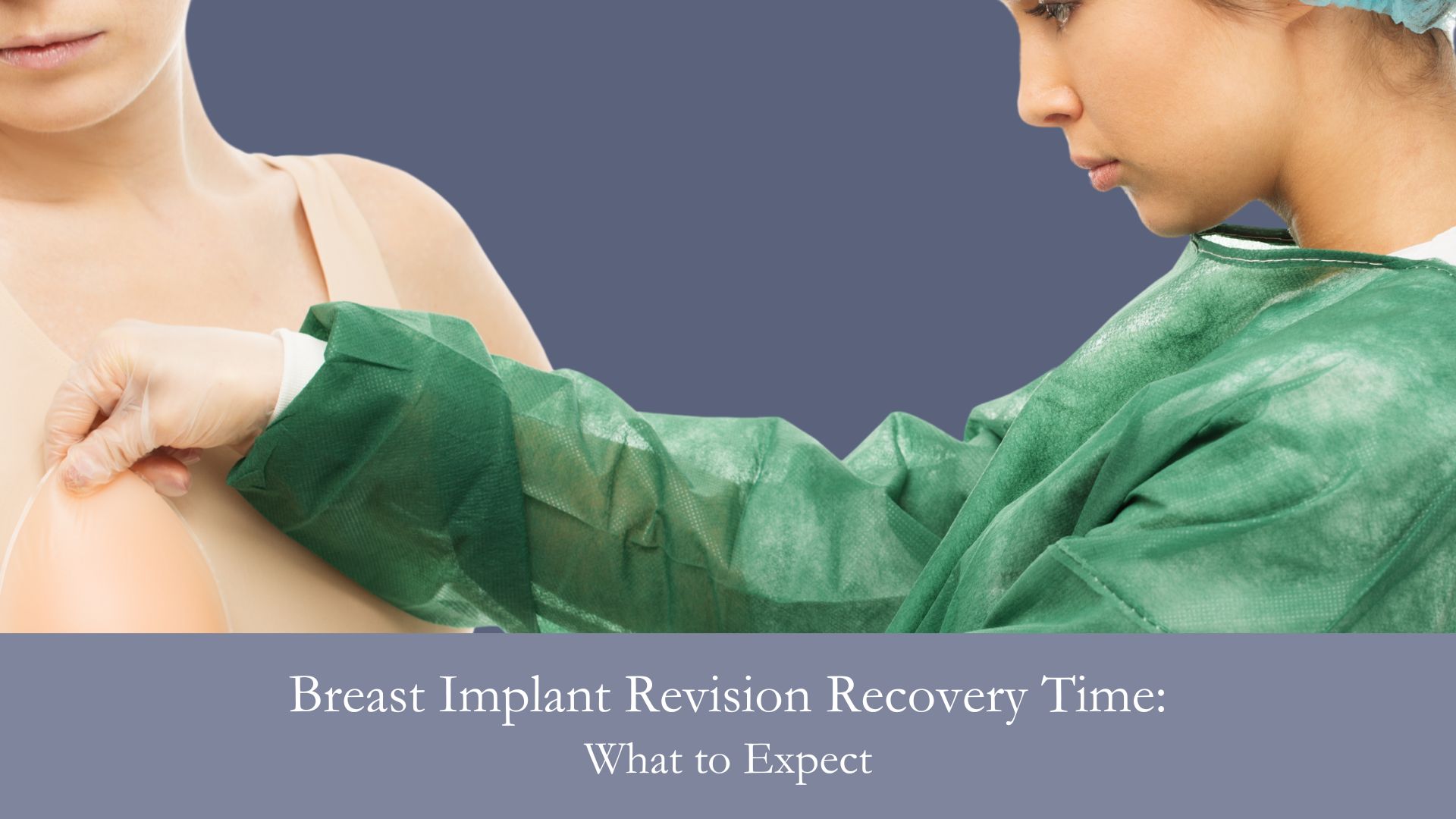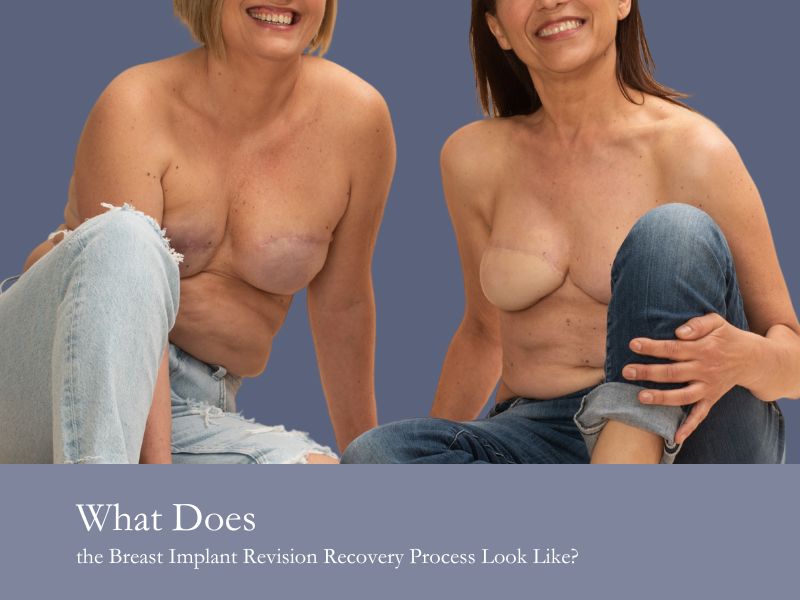Wanting to see the improved results of your breast implant revision surgery is exciting, but patience is key. If you don’t follow your surgeon’s recommendations closely, you could delay your recovery or potentially need another visit to the office.
Breast implant revision recovery time is usually similar for removal or replacements, but there are a few details that could lengthen this period. If you’re considering breast augmentation surgery, learning about details like scar tissue and lifestyle changes will help prepare you for the weeks to follow.
Table of Contents
How Long Does it Take to Recover From Breast Implant Revision Surgery?
The length of time depends on factors such as the surgery type, lifestyle, and your body’s natural changes. Most patients who receive breast implant replacement will recover within a few weeks, though this period could take longer if you experience complications or don’t follow your surgeon’s recovery recommendations.
New breast implants usually take a little longer to recover from than breast implant removal. Again, this is not a hard and fast rule, so keep in close contact with your plastic surgeon during your recovery.
What Does the Breast Implant Revision Recovery Process Look Like?
Whether you need new silicone implants or need to fix slight asymmetry, there will still be a significant recovery period to help your body scar over and heal. We’ll help you paint a picture of what your recovery process could look like after you replace breast implants or remove them.
1. Your Surgeon Will Give You a Clear Outline on What to Do Afterward
Once you’re done with your operation, your plastic surgeon will give you a detailed outline of what to expect for the next few weeks. Similar to your initial surgery, you’ll receive a list on the following:
- General lifestyle requirements and activities to avoid
- Medications you’ll be allowed to take
- Which medications and medical supplies to avoid
- How to take care of the incision site to reduce the risk of infection
- Best follow-up times
While you may be worried about implant displacement or visible bruising in the first few days, it’s important to wait and give your body time to adapt to the implants. Your surgeon will make it clear which signs are abnormal (like an implant rupture or infection) and which ones are perfectly fine (initial swelling or bruising).
2. You Will Receive a Compression Garment and Surgical Drains
After plastic surgery, you’ll notice your breasts feeling very swollen and uncomfortable. Your plastic surgeon will proceed to give you a compression garment to keep the swelling under control and speed up your recovery.
Since the surgical site needs time to flush out bacteria and build up scar tissue, you’ll also experience a little draining for the first week or so. These fluids are usually a mixture of blood and a thin, clear discharge called serous fluid. This fluid is normal in small amounts and a sign your body is naturally healing.
If you notice thick white, yellow, or green discharge, that’s a sign of an infection and a detail you should immediately contact your surgeon about.
3. You’ll Need to Focus on Significant Rest for a Few Weeks
While you may feel ready to go just days after breast surgery, rest is crucial for helping your body stitch itself back together. Consistent rest strengthens your immune system to fight potential infection, while your natural cell turnover has time to help heal the incision site.
You’ll need to avoid certain activities such as contact sports, heavy exercise, and lifting heavy loads. These activities risk splitting open your incision site or making the swelling worse.
You will also receive instructions on when you’re able to shower and what sleeping positions you can take. While these details can seem tedious or frustrating, they’re important for helping you heal as fast as possible.
What are Complications Following Breast Implant Revision Surgery?
The breast implant revision procedure is generally safe and comes with no complications. However, all forms of surgery carry some form of risk due to cutting the skin and tissue.
Below are a few complications to keep an eye out for during your recovery period.
Capsular Contracture
This term refers to the build-up of scar tissue around an implant after surgery. Since your body naturally defaults to healing itself after experiencing incisions, this hardened tissue can potentially cause discomfort or tenderness.
While most forms of capsular contracture show no symptoms and minimal cosmetic changes, this condition can sometimes cause enduring discomfort. Reach out to your surgeon if you’re noticing swelling, tenderness, or tightness several weeks after your procedure.
Infection
Breast revision surgery requires a sterile environment and a licensed, board certified plastic surgeon to pull off successfully. There is still a small risk of infection that could delay recovery time.
The most common signs of infection for a breast implant revision or breast implant removal are:
- Unusual swelling or visible bruising several weeks after the procedure
- Fluid discharge or pus
- Persistent redness and tenderness
- High-grade fever
- A build-up of fluid around the injection site
How Much is Breast Implant Revision Surgery?
Your surgeon will discuss the exact breast revision cost after looking at several factors. They’ll ask you about your health insurance, consider anesthesia costs, and discuss the implants you want.
For example, saline implants are usually lower cost than silicone implants. However, your costs could still be higher if you also want a breast lift or complementary cosmetic procedures like a tummy tuck.
The average breast revision surgery cost hovers around $4,000 to $6,000 for simpler procedures, but can reach $15,000 or more for complex work.
Frequently Asked Questions: Breast Implant Revision Recovery Time
A breast augmentation revision is a major decision and one you shouldn’t make lightly. We’ll answer a few more of your questions so you can feel fully prepared reaching out to a surgical facility.
How Painful is Breast Revision Surgery?
Your mileage may vary depending on your personal pain levels and experience with cosmetic surgery in general. Some patients actually report less pain, while others will feel the same as the initial breast augmentation.
How Long Do I Have to Sleep on My Back After Breast Revision?
Plastic surgeons will generally recommend waiting between three to six weeks after surgery before sleeping on your side or front. Sleeping on your back keeps pressure off your incision site to reduce discomfort and swelling.
How Long After a Breast Augmentation Can I Lift My Arms?
Lifting your arms too soon after breast augmentation surgery can cause your implants to leave the breast pockets your surgeon created for them, changing the implant shape or placement. Surgeons will recommend waiting around two weeks before lifting your arms above your head.
Contact Us Today to Discuss Your Implant Revision Surgery
The recovery process for modifying or removing existing implants is complex and requires constant vigilance. However, an experienced plastic surgeon is your trusted partner on your personal health or cosmetic journey.
Dr. Sanam Zahedi at Zahedi Plastic Surgery is a board-certified plastic surgeon with a background in breast implant revision as well as breast lifts and breast reduction. Reach out today to talk about your breast implant revision cost and get closer to the appearance you’ve always wanted.



